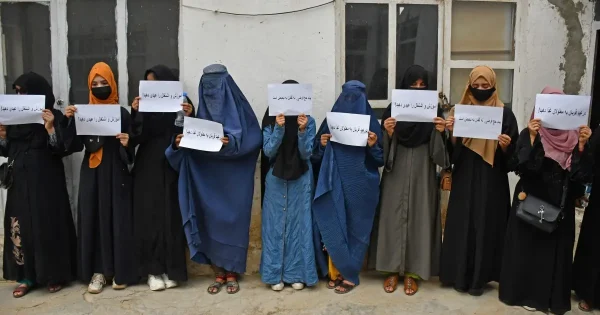After 50 years of women fighting for their rights in Afghanistan, they are still struggling to this day. This is due to NATO allies removing their troops from Afghanistan in 2021, and the Taliban has emerged once again, degrading women’s rights. Now, the Taliban has recently cut off all ways to educate women entirely. Even as women have been taking courses training as midwives and nurses, the Taliban has shut down all education routes for women [1.5].
Before the Taliban came into Kabul in September of 1996 [2], women had more rights and freedom in Afghanistan. Girls and boys went to school together from first grade to twelfth grade [3] and women were allowed to participate in a more publicly active life [4].
From 1933 to 1973, Mohammed Zahir Shah ruled Afghanistan, focusing more on women’s rights. [5] Under his rule, women were able to leave their homes and work again, and many female universities were developed. It was also not permitted to cover women’s bodies in public, and Afghan women were gaining political power, being able to vote and having the opportunity to run for elected positions. In 1950, The Purdah system was removed from Afghanistan, and it had enforced strict gender segregation and veiling practices [6]. King Mohammed Zahir Shah wanted to improve the political, social, and legal status of women in Afghanistan [7]. When the system was removed, this was a major turning point for women’s rights. Up until the 1970s, women’s rights started to increase, and were taken more seriously due to the rule of Mohammed Zahir Shah who looked to improve womens’ overall status. After the year 1970, conflict with Mujahideen groups, Muslims who fight on behalf of their religion, erupted during the Soviet-Afghan war, causing the fall of women’s rights.

As the Mujahideen fought for control over Afghanistan from 1992 to 1996, women’s rights were not a top priority due to all the conflict, and they were faced with violence and repression. Strict laws were enforced such as: women were forced to wear burqas, they could not leave their home without a male figure, and they lost the rights to education and employment [8].
In 1996, the Taliban, led by a former Mujahideen commander, took full control of the country [9]. The Taliban made their way to Kabul, Afghanistan, where they killed the country’s president and instituted a strict interpretation of Islamic law, as women were denied basic rights. Women were confined to living in their homes, unless accompanied by a male guardian, and were prohibited from working and studying.
During October, 2001, the US and Allied Forces invaded Afghanistan, overtaking the Taliban regime, in search of terrorist leader, Osama Bin Laden, after the attack on 9/11. The Taliban relocated to southern Afghanistan and Pakistan [10].
In 2009 president of Afghanistan, Hamid Karzai, and the Afghan Parliament passed laws regarding the elimination of violence against women (EVAW). The objective of this law was to protect women who are victims of or at risk of violence, providing public awareness and training on violence against women, and preventing violence against women. This Parliament helped women have more of a say in both political and public life, compared to life in years prior when women couldn’t even speak loudly in public [11].
After the EVAW was passed, schools were reopened to girls and women went back to working. Women’s rights were gradually starting to grow due to the adoption of EVAW law. Despite the progress that women had made to gain their rights in Afghanistan, discrimination against women still occurred and government focus was mainly on armed conflict [12].
In 2020, the United States and Taliban signed an agreement on the removal of international forces from Afghanistan in May 2021. [13] As of 2021, after 20 years of having troops there, international forces removed their troops from the country. After the departure of United States and Allied troops, the Taliban quickly gained control again in Afghanistan and the government in Kabul.
After the Taliban takeover in Afghanistan once again in 2021, there has been violence and discrimination against women and girls across the country. Women and girls went to the streets of Afghanistan to protest. They were met with violence, detention and some were killed. The Taliban wanted to lessen the presence of women and girls and they were erased from public and social life. They have been banned from attending secondary school, working, appearing on television, or simply going to a park [14].

Currently in Afghanistan, women are visible in small numbers on streets, and all women are covered from head to toe wearing dark clothes and burqas, some even covering their eyes with mesh. Women and girls have been attacked for not following the strict laws that the Taliban has imposed on them. Women are abused and sent to prison for not abiding by the laws [15].
Some of the primary laws affecting women include: women and girls wearing the veil at all times in public, covering their face is essential; women’s voices need to be quiet or completely silent; women cannot be heard singing, reciting, or reading aloud; it is forbidden for women to look at another man if they are not related to him by blood or marriage; girls are banned from going to school above sixth grade; and women are prohibited from attending universities. Officers search bus stops and shopping malls in search of women who violate the dress code or women who might raise their voices or laugh [16]
As the Taliban enforces new strict laws, Afghan women say that the hope they once had of the Taliban easing up on their strict regulations, has vanished [17]




Jeffrey Morse • Dec 4, 2024 at 10:26 pm
Eva, that’s an excellent job of reporting on the current situation of oppression in Afghanistan. Providing a time-line of events that highlights the extreme degradation of women’s rights was very helpful, yet the reality is so unfortunate and sad. It is beyond comprehension of most people in America. One can only imagine the impact of strict oppressive law on the mental health of the women of Afghanistan.